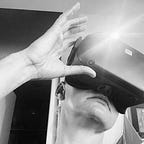VR is the discomfort machine — and that’s a good thing
“That,” said my husband after he went through our latest racial bias VR experience, “was super uncomfortable.” He said it almost hesitantly, as if he didn’t want to criticize the work, but it was exactly what I wanted to hear, and it was echoed by all the white people I put through the experience. In it, you play someone on the receiving end of biased behavior, but you don’t know why you’re being harassed until the end. In the meantime, you’re just left feeling strange and wondering why, exactly, this clerk has it in for you.
For the record, everyone non-white person who saw the experience shrugged and said, “yeah, you pretty much nailed it,” when they took the headset off.
The old “VR is the empathy machine” line is still getting thrown around, and for good reason. But what if we thought bigger than that? After all, empathy only goes so far, and being empathetic to someone’s experience or position has limited utility. What if we extended this to think about how we could use VR to put a person not just in someone else’s shoes, but allow them to feel what it is like to live their experience?
Putting a user in someone else’s shoes has limited impact. I can’t undo 41 years of being a white woman and an American citizen just by slipping a Quest on my face, and asking me to do so strains credulity. It also diminishes the lived experience of the person I’m supposed to embody. But if I can, as myself, have a similar experience to those they face on a daily basis, I can begin to understand what it feels like to live a certain type of life.
VR is a great medium for this, far better than any book or video could ever hope to be. The user is essentially stuck in the scenario, and while they could always remove the headset if it gets too uncomfortable, chances are they won’t. This is especially true in a training scenario, where the user has to complete the piece. They are also face-to-face with the person they are dealing with, and can’t find another thing to distract them in order to avoid the confrontation. Making the user face something head on is the best way to get them to open their minds, or at least understand what some people face every day.
One of the biggest barriers to true empathy is that we simply cannot imagine another person’s lived experience, so we default to dismissing it or minimizing it. By using VR to put people in these experiences and have them “live” them as themselves, we can create openings for deeper understanding.
